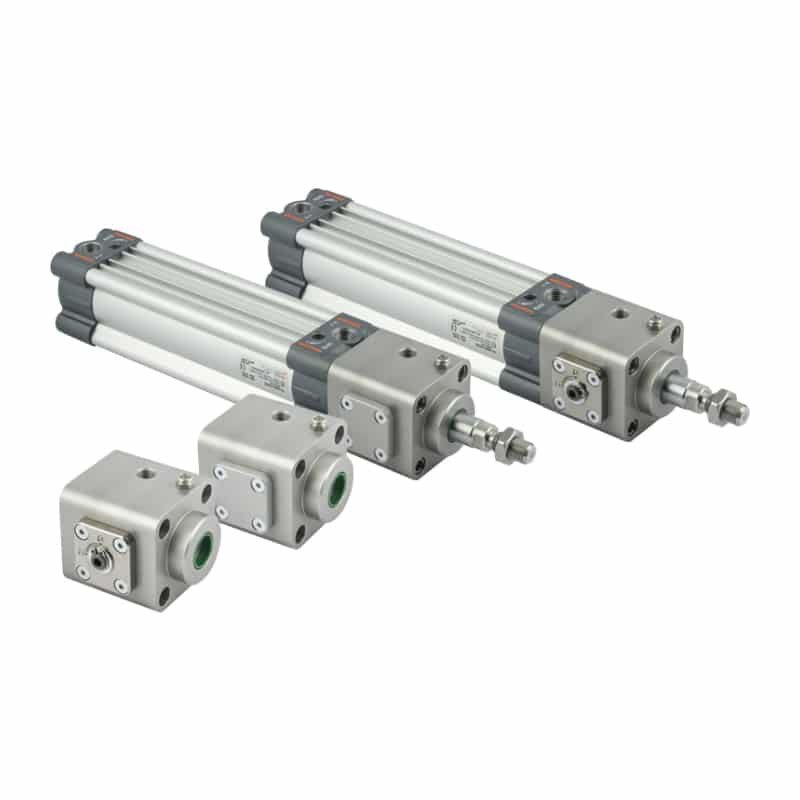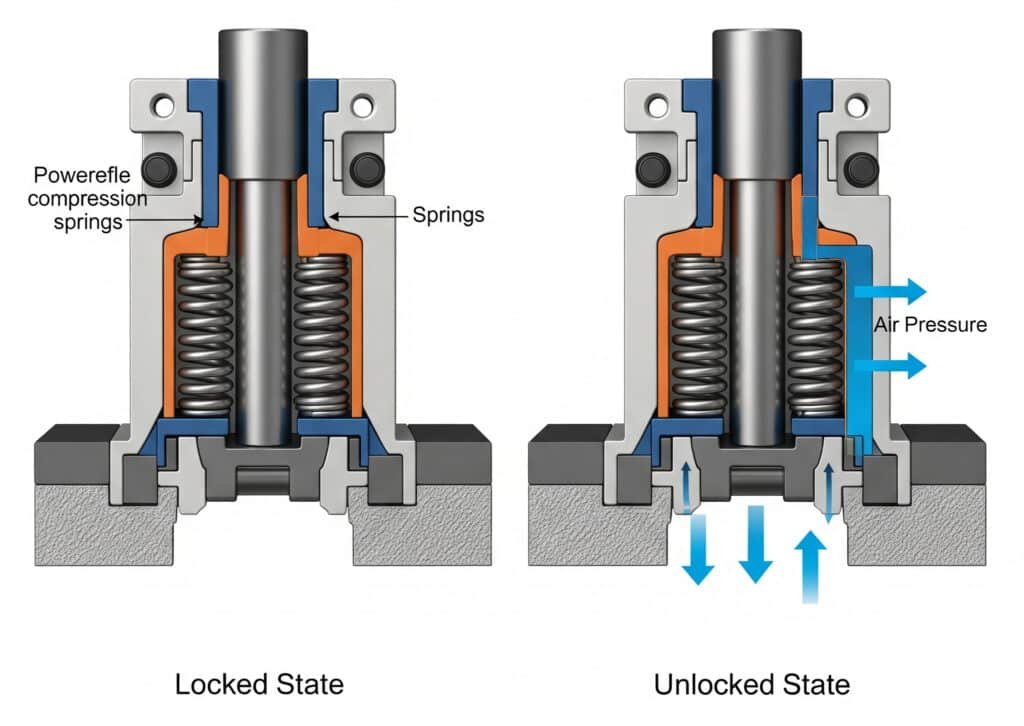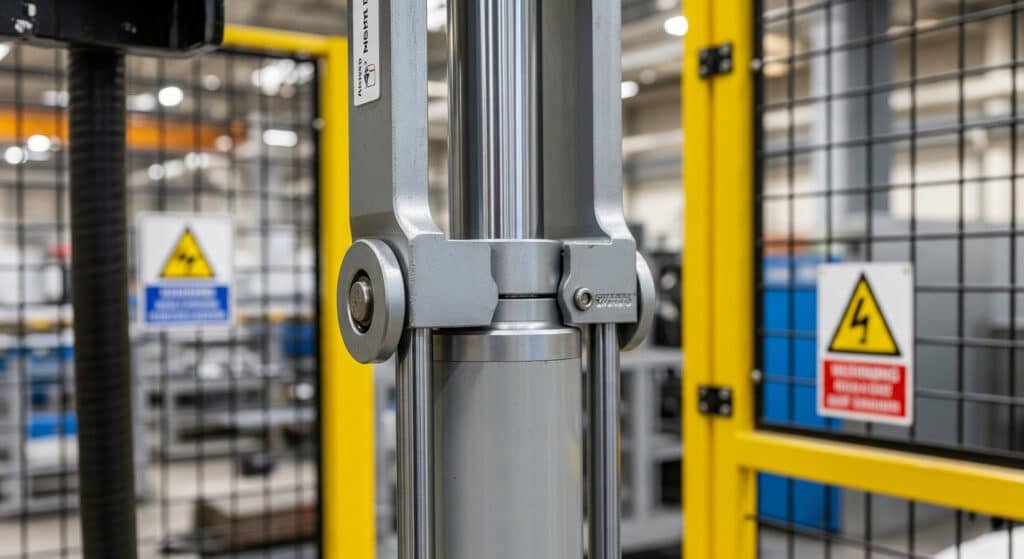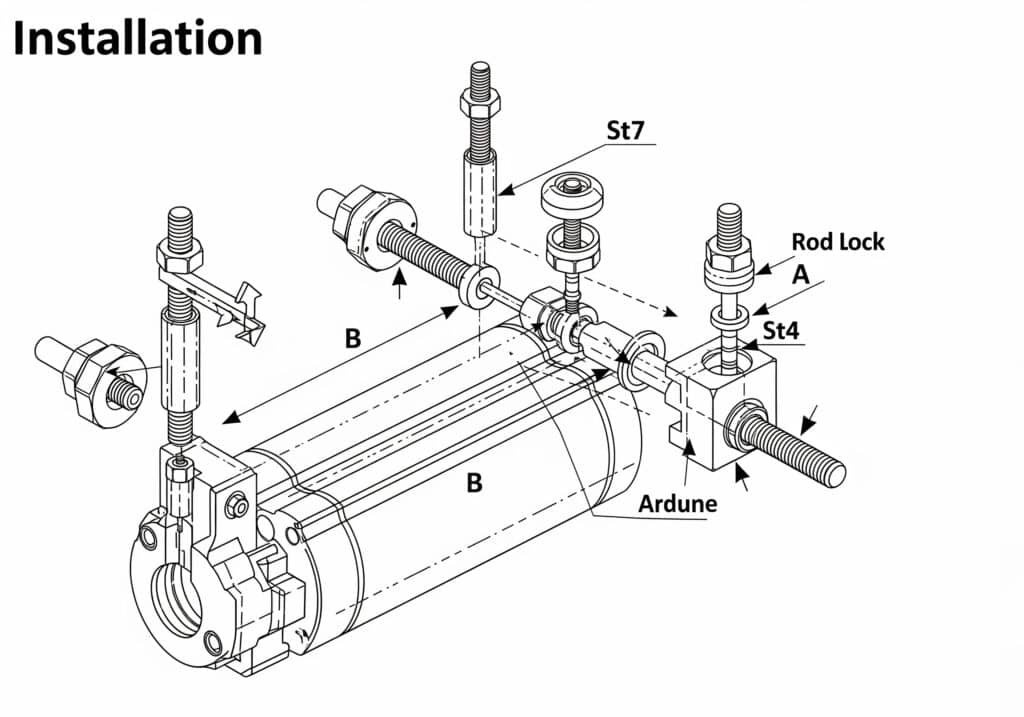
Industrial accidents from falling loads kill dozens of workers annually. Cylinder rod locks prevent catastrophic failures when pneumatic pressure drops unexpectedly. Many engineers underestimate their importance until facing liability issues or safety violations.
Cylinder rod locks are mechanical safety devices that physically secure pneumatic cylinder rods in position when air pressure is lost, preventing dangerous load drops through spring-loaded wedging or clamping mechanisms.
Last year, I received an urgent call from Maria Rodriguez, a safety manager at a Texas manufacturing plant. Their overhead pneumatic cylinders lost pressure during a power outage, dropping heavy automotive parts that nearly injured three workers. Installing proper rod locks prevented future incidents and saved the company from potential lawsuits.
Table of Contents
- What Are the Basic Operating Principles of Cylinder Rod Locks?
- What Are the Different Types of Cylinder Rod Lock Mechanisms?
- How Do Spring-Loaded Rod Locks Function in Emergency Situations?
- Where Are Cylinder Rod Locks Most Critical for Safety?
- How Do You Select the Right Rod Lock for Your Application?
- What Are Common Installation and Maintenance Requirements?
- Conclusion
- FAQs About Cylinder Rod Locks
What Are the Basic Operating Principles of Cylinder Rod Locks?
Cylinder rod locks operate on fail-safe1 mechanical principles that engage automatically when pneumatic pressure drops below safe operating levels. These devices provide the last line of defense against catastrophic load drops.
Rod locks use spring-loaded mechanisms that engage mechanically with the cylinder rod when air pressure is insufficient to maintain safe load support, creating a positive mechanical connection independent of pneumatic power.

Mechanical Engagement Theory
Rod locks function through mechanical interference between locking elements and the cylinder rod surface. When engaged, they create a positive mechanical connection that can support the full rated load without relying on air pressure.
The basic operating sequence follows these steps:
- Normal Operation: Compressed air holds locking mechanism in disengaged position
- Pressure Drop Detection: Built-in pressure switch monitors system pressure
- Automatic Engagement: Spring force overcomes air pressure, engaging lock
- Load Support: Mechanical elements support full load weight
- Manual Release: Operator must manually disengage before resuming operation
Force Distribution Analysis
Rod locks must distribute clamping forces evenly across the rod surface to prevent damage while providing adequate holding strength. The clamping force calculation considers:
| Factor | Typical Range | Impact on Performance |
|---|---|---|
| Clamping Force | 500-5000 lbs | Determines holding capacity |
| Contact Area | 0.5-3 sq inches | Affects stress concentration |
| Rod Material | Steel/Stainless | Influences wear resistance |
| Surface Hardness | 40-60 HRC | Prevents galling and wear |
Pressure Threshold Settings
Most rod locks engage when system pressure drops below 60-80% of normal operating pressure. This threshold provides safety margin while preventing nuisance lockups during normal pressure fluctuations.
Typical Pressure Settings:
- Engagement Pressure: 50-70 PSI (for 100 PSI systems)
- Release Pressure: 80-90 PSI (ensures full disengagement)
- Hysteresis Band: 10-20 PSI (prevents chattering)
Safety Factor Calculations
Rod locks must support loads significantly greater than normal operating loads to account for dynamic forces, shock loading, and safety margins required by industrial standards.
Safety Factor Formula: Lock Capacity = Operating Load × Safety Factor
Industry standards typically require safety factors of 3:1 to 5:1 for critical applications, meaning a 1000-pound load requires a rod lock rated for 3000-5000 pounds holding capacity.
What Are the Different Types of Cylinder Rod Lock Mechanisms?
Various rod lock designs address different application requirements and installation constraints. Each type offers specific advantages for particular operating conditions and safety requirements.
The main types include wedge locks, collet locks, brake-style locks, and integrated cylinder locks, each using different mechanical principles to achieve positive rod retention.
Wedge-Type Rod Locks
Wedge locks use tapered mechanical elements that grip the cylinder rod when engaged. Spring force drives the wedges against the rod surface, creating a self-energizing clamping action2.
Wedge Lock Advantages:
- High Holding Force: Self-energizing action multiplies spring force
- Compact Design: Minimal space requirements around cylinder
- Quick Engagement: Rapid response to pressure loss
- Adjustable Clamping: Can accommodate rod wear and tolerance variations
Operating Characteristics:
- Engagement Time: 50-200 milliseconds
- Holding Capacity: Up to 10,000 pounds
- Rod Size Range: 0.5 to 6 inches diameter
- Operating Temperature: -20°F to +200°F
Collet-Type Rod Locks
Collet locks use flexible steel fingers that contract around the rod when actuated. This design provides uniform clamping pressure around the entire rod circumference.
The collet mechanism offers several benefits:
- Even Pressure Distribution: Reduces rod surface stress
- Smooth Engagement: Gradual clamping action
- Rod Protection: Minimal surface marking or damage
- Reversible Operation: Can function in both directions
Brake-Style Rod Locks
Brake-style locks use friction pads or bands that clamp onto the rod surface. These systems provide excellent holding force with minimal rod wear.
Brake Lock Features:
| Component | Function | Material Options |
|---|---|---|
| Friction Pads | Provide gripping surface | Organic/Metallic/Ceramic |
| Actuating Mechanism | Applies clamping force | Spring/Pneumatic/Hydraulic |
| Housing | Contains mechanism | Aluminum/Steel/Cast Iron |
| Adjustment System | Compensates for wear | Manual/Automatic |
Integrated Cylinder Rod Locks
Some manufacturers offer cylinders with built-in rod locking mechanisms. These integrated systems provide seamless operation and optimal space utilization.
Integrated designs typically use internal wedging mechanisms activated by pilot air pressure. When main system pressure drops, the pilot circuit engages the internal lock automatically.
How Do Spring-Loaded Rod Locks Function in Emergency Situations?
Spring-loaded rod locks provide fail-safe operation by using stored mechanical energy to engage when pneumatic power fails. Understanding their emergency response characteristics is crucial for safety system design.
Spring-loaded mechanisms use compressed springs to provide engagement force, ensuring positive locking action even during complete air system failure or power outages.
Emergency Response Timeline
Rod lock response time during emergencies directly affects safety outcomes. Faster engagement reduces the distance a load can fall before the lock activates.
Typical Response Sequence:
- Pressure Loss Detection: 10-50 milliseconds
- Spring Extension: 25-100 milliseconds
- Mechanical Engagement: 50-200 milliseconds
- Full Lock Engagement: 100-300 milliseconds total
Spring Design Considerations
Springs must provide sufficient force throughout their operating range while maintaining reasonable engagement speeds. Spring calculations consider:
Spring Force Requirements:
- Overcome air pressure during engagement
- Provide adequate clamping force when engaged
- Account for spring fatigue over service life
- Maintain force consistency across temperature range
Spring Specifications:
| Parameter | Typical Range | Design Impact |
|---|---|---|
| Spring Rate | 50-500 lbs/inch | Controls engagement speed |
| Preload Force | 100-1000 lbs | Sets minimum clamping force |
| Working Stress | 60-80% of yield | Ensures long service life |
| Temperature Range | -40°F to +250°F | Material selection critical |
Load Arrest Dynamics
When rod locks engage during emergency situations, they must absorb the kinetic energy3 of falling loads. This creates significant dynamic forces that exceed static load calculations.
Dynamic Load Factor: Emergency loads can be 2-5 times greater than static loads due to impact forces when the lock engages.
The energy absorption calculation follows: Kinetic Energy = ½mv²
Where falling loads gain velocity according to: v = √(2gh)
For a 1000-pound load falling 6 inches before lock engagement:
- Velocity at impact: 5.67 feet per second
- Kinetic energy: 500 foot-pounds
- Dynamic force: Approximately 2500-3000 pounds
Where Are Cylinder Rod Locks Most Critical for Safety?
Certain applications present higher risks and require mandatory rod lock installation. Understanding these critical applications helps engineers identify where rod locks are essential for worker safety and regulatory compliance.
Rod locks are most critical in vertical lifting applications, overhead installations, personnel access areas, and processes involving hazardous materials where cylinder failure could cause injury or environmental damage.

Vertical Lifting Applications
Any pneumatic cylinder supporting loads against gravity requires rod lock protection. Vertical applications present the highest risk because gravity immediately acts on unsupported loads.
Critical Vertical Applications:
- Lift Tables and Platforms: Worker access and material handling
- Overhead Doors and Gates: Personnel protection systems
- Vertical Presses: Manufacturing and assembly operations
- Material Hoists: Parts and equipment movement
- Safety Barriers: Emergency isolation systems
Personnel Access Areas
Rod locks become mandatory when cylinder failure could injure workers or block emergency exits. Safety regulations often require positive mechanical locking in these situations.
I worked with a Canadian food processing plant where pneumatic doors controlled access to clean rooms. After a near-miss incident when a door dropped during shift change, we installed rod locks on all personnel access cylinders. The investment was minimal compared to potential liability costs.
Hazardous Material Handling
Applications involving toxic, flammable, or corrosive materials require additional safety measures. Rod lock failure in these environments could cause environmental damage or worker exposure.
High-Risk Material Applications:
- Chemical Processing: Valve and damper control
- Waste Treatment: Containment system operation
- Pharmaceutical: Clean room isolation
- Food Processing: Sanitary system controls
- Nuclear: Radiation containment systems
Regulatory Compliance Requirements
Various safety standards mandate rod lock installation in specific applications:
| Standard | Application Scope | Rod Lock Requirements |
|---|---|---|
| OSHA 1910.1474 | Lockout/Tagout | Positive isolation required |
| ANSI B11.19 | Machine Safety | Gravity-affected loads |
| ISO 13849 | Safety Systems | Category 3/4 applications |
| NFPA 70E | Electrical Safety | Arc flash protection |
How Do You Select the Right Rod Lock for Your Application?
Proper rod lock selection requires analyzing load characteristics, environmental conditions, and safety requirements. Incorrect selection can result in inadequate protection or premature failure.
Selection criteria include load capacity, rod diameter compatibility, environmental conditions, response time requirements, and integration with existing safety systems.
Load Analysis and Sizing
Rod lock capacity must exceed maximum expected loads including dynamic forces, safety factors, and environmental conditions that could increase loading.
Load Calculation Steps:
- Determine Static Load: Weight of supported components
- Calculate Dynamic Forces: Impact and acceleration loads
- Apply Safety Factor: Typically 3:1 to 5:1 minimum
- Consider Environmental Factors: Temperature, vibration, corrosion
- Select Lock Capacity: Must exceed calculated requirements
Environmental Compatibility
Operating environment significantly affects rod lock performance and service life. Material selection and sealing systems must match application conditions.
Environmental Factors:
| Condition | Impact on Selection | Required Features |
|---|---|---|
| Temperature Extremes | Material properties change | Special alloys/seals |
| Corrosive Atmosphere | Accelerated wear/failure | Stainless steel/coatings |
| Washdown Requirements | Water ingress protection | IP65/IP67 sealing |
| Explosive Atmosphere | Ignition source prevention | ATEX5/FM approval |
| High Vibration | Fatigue and loosening | Reinforced mounting |
Integration with Safety Systems
Rod locks must integrate properly with overall machine safety systems including emergency stops, light curtains, and safety PLCs.
Modern rod locks often include:
- Position Feedback: Confirm lock engagement
- Pressure Monitoring: Detect system problems
- Manual Release: Emergency operation capability
- Status Indication: Visual/audible engagement confirmation
Response Time Requirements
Different applications require different response times based on risk assessment and load characteristics.
Application Response Requirements:
- Personnel Protection: Under 100 milliseconds
- Equipment Protection: 200-500 milliseconds
- Process Control: 500-1000 milliseconds
- General Safety: Under 1 second
What Are Common Installation and Maintenance Requirements?
Proper installation and maintenance ensure rod locks function reliably when needed. Poor installation is the leading cause of rod lock failure in emergency situations.
Installation requires proper mounting, alignment, pressure connections, and testing procedures, while maintenance includes regular inspection, lubrication, and functional testing.

Installation Best Practices
Rod lock installation affects both normal operation and emergency performance. Proper procedures prevent common problems that could compromise safety.
Critical Installation Steps:
- Verify Rod Condition: Surface finish and straightness requirements
- Check Alignment: Rod must be perpendicular to lock housing
- Secure Mounting: Use proper torque specifications and thread locker
- Connect Air Lines: Ensure proper pressure supply and venting
- Adjust Settings: Set engagement and release pressures correctly
- Test Operation: Verify engagement under simulated emergency conditions
Mounting Considerations
Rod lock mounting must withstand full emergency loads without deflection or failure. Inadequate mounting is a common cause of safety system compromise.
Mounting Requirements:
| Load Direction | Mounting Method | Bolt Grade | Safety Factor |
|---|---|---|---|
| Axial (Rod Direction) | Through-bolts preferred | Grade 8 minimum | 4:1 minimum |
| Radial (Side Loading) | Reinforced brackets | High tensile | 5:1 minimum |
| Combined Loading | Engineering analysis | Certified fasteners | Per calculation |
Maintenance Schedule and Procedures
Regular maintenance prevents rod lock failure during emergencies. Maintenance frequency depends on operating conditions and manufacturer recommendations.
Recommended Maintenance Schedule:
- Daily: Visual inspection for damage or leaks
- Weekly: Function test under no-load conditions
- Monthly: Full load engagement test
- Quarterly: Lubrication and adjustment check
- Annually: Complete disassembly and inspection
Common Maintenance Issues
Understanding common problems helps maintenance personnel identify potential failures before emergency situations occur.
Frequent Problems and Solutions:
- Slow Engagement: Clean and lubricate mechanism, check spring condition
- Incomplete Locking: Adjust engagement pressure, inspect wear components
- Rod Surface Damage: Check alignment, replace worn pads/wedges
- Air Leakage: Replace seals, check fitting connections
- False Engagement: Adjust pressure settings, check control system
Testing and Validation
Regular testing ensures rod locks will function properly during actual emergencies. Testing procedures should simulate real operating conditions as closely as possible.
Testing Protocol:
- No-Load Test: Verify engagement without applied load
- Partial Load Test: Test with 50% of rated load
- Full Load Test: Verify holding capacity at maximum load
- Response Time Test: Measure engagement speed
- Release Test: Confirm proper disengagement
Conclusion
Cylinder rod locks provide essential safety protection through mechanical fail-safe operation that prevents dangerous load drops when pneumatic pressure fails, making them critical components for worker safety and regulatory compliance.
FAQs About Cylinder Rod Locks
How does a cylinder rod lock work?
Rod locks use spring-loaded mechanisms that engage mechanically with the cylinder rod when air pressure drops, creating a positive mechanical connection that supports loads independent of pneumatic power.
When are rod locks required for safety?
Rod locks are required in vertical lifting applications, overhead installations, personnel access areas, and anywhere cylinder failure could cause injury, property damage, or environmental hazards.
What is the typical response time for rod lock engagement?
Most rod locks engage within 100-300 milliseconds of pressure loss, with high-speed units responding in under 100 milliseconds for critical personnel protection applications.
How much load can a rod lock support?
Rod lock capacity ranges from 500 to 50,000 pounds depending on size and design, with safety factors of 3:1 to 5:1 required for most industrial applications.
Do rod locks work in both directions?
Most rod locks work in one direction only (typically preventing rod retraction), though bidirectional units are available for applications requiring locking in both extension and retraction directions.
How often should rod locks be tested?
Rod locks should be function tested weekly under no-load conditions and monthly under full load, with complete inspection and maintenance performed quarterly or per manufacturer recommendations.
-
Provides an explanation of the fail-safe design philosophy, a principle that ensures a system will inherently revert to a state that causes no harm to people or equipment in the event of a failure. ↩
-
Describes the mechanical advantage of a self-energizing or self-locking wedge, where the friction forces created by an applied load increase the clamping force, preventing slippage. ↩
-
Offers a foundational explanation of kinetic energy, the energy that an object possesses due to its motion, calculated as ½mv², which is a critical factor in understanding impact forces. ↩
-
Provides information on the OSHA 1910.147 standard, also known as Lockout/Tagout (LOTO), which outlines the requirements for controlling hazardous energy during the service and maintenance of machinery. ↩
-
Explains the ATEX directives, which are European Union regulations describing the minimum safety requirements for equipment and protective systems intended for use in potentially explosive atmospheres. ↩



